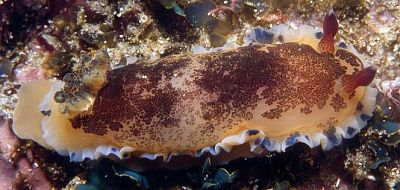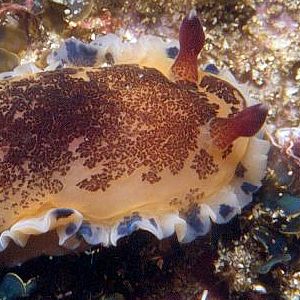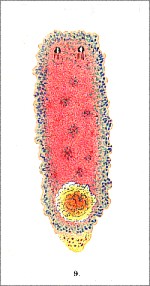Dendrodoris kalkensis? from Sth Africa
August 6, 2001
From: Valda Fraser


Dear Bill,
I have found a nudibranch I am unable to identify. I hope you can help.
Locality: Brazenhead, Eastern Cape, Sth Africa, 25m.
Date: July 2001
Size: 40mm
Thanks,
Valda Fraser
valdafraser@mweb.co.za
Fraser, V., 2001 (Aug 6) Dendrodoris kalkensis? from Sth Africa. [Message in] Sea Slug Forum. Australian Museum, Sydney. Available from http://www.seaslugforum.net/find/4859
Dear Valda,
This fits Barnard's description of Dendrodoris kalkensis very well. Gosliner thinks it is probably the same as as Dendrodoris caesia (Bergh, 1907) but Bergh's description of a single preserved specimen is to me unidentifiable.
Doriopsis caesia:
"the living animal is noted to have been bluish. Preserved it was whitish, with the margin of the back more grayish ...."
There are some an anatomical details which place it in Dendrodoris. [Bergh 1907]
Compare this with with Barnard's description of Doris? kalkensis which included the colour painting reproduced alongside:
"A single large specimen of a large dorid was found at low tide at St James, False Bay... A coloured drawing was made of living animal... but the specimen was accidentally destroyed." [Barnard, 1927 - Pl 19, fig 9].
Barnard (1932) reported on another living specimen from the same locality. He described it as similar in colour to original specimen except the middle of back was darker red and the blue spots around the edge were larger and more or less confluent into patches. Rhinophores were dark red-brown at the base, the clubs blue-black with white tips. The gills were pale salmon with blue-grey speckles. He was also able to examine its anatomy and show that it was a species of Dendrodoris.
The only difference between your photo and Barnard's description is the red background colour of the mantle. Looking at your photo the mantle seems to be translucent so the colour of the viscera will largely determine the background colour of the animal. I suspect that the degree of 'redness' may depend on the colour of the sponges the nudibranch has been eating. In other colour details your animal is a good match. In my opinion there is little point in using Bergh's name as there is nothing in his description that could be used to positively identify his 'species'.
In Terry Gosliner's book he illustrates a black speckled animal as D. caesia and says it is very common in the Indian Ocean reion of the Cape Province, S.Africa. he does not say how variable in colour it is and whether this orange-brown and blue spotted 'form' are part of its colour variation. I look forward to some comment from Terry.
References:
• Barnard, K.H. (1927) South African nudibranch mollusca, with descriptions of new species, and a note on some specimens from Tristan d'Acunha. Annals of the South African Museum, 25(1): 171-215, Pls 19,20.
• Barnard, K.H. (1932) Note on the true genus of Doris (?) kalkensis Barnard. Journal of Conchology, 19(8): 256-257.
• Bergh, L.S.R. (1907) Marine Investigations of South Africa 5(1). The Opisthobranchiata of South Africa. Transactions of the South African Philosphical Society, 17(1): 1-144. Pls. 1-14.
Best wishes,
Bill Rudman.
Related messages
-
Dendrodoris caesia and D. kalkensis
From: Terry Gosliner, August 8, 2001
